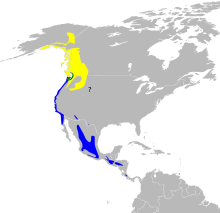Townsend's warbler (Setophaga townsendi) is a small songbird of the New World warbler family.
| Townsend's warbler | |
|---|---|
 | |
| Scientific classification | |
| Domain: | Eukaryota |
| Kingdom: | Animalia |
| Phylum: | Chordata |
| Class: | Aves |
| Order: | Passeriformes |
| Family: | Parulidae |
| Genus: | Setophaga |
| Species: | S. townsendi |
| Binomial name | |
| Setophaga townsendi (Townsend, 1837) | |
 | |
| Range of S. townsendi Breeding range Year-round range Wintering range | |
| Synonyms | |
Sylvia townsendi (protonym) | |
Taxonomy
Townsend's warbler was formally described in 1837 by the American naturalist John Kirk Townsend under the binomial name Sylvia townsendi.[2] The type locality is Fort Vancouver on the Columbia River in the state of Washington.[3] After the merger of the genera Dendroica and Setophaga,[4] Townsend's warbler is now placed in the genus Setophaga that was introduced by the English naturalist William Swainson in 1827.[5][6] The species is monotypic: no subspecies are recognised.[6]
Description
Townsend's warbler has a yellow face with a black stripe across its cheeks extending into an ear patch, a thin pointed bill, two white wing bars, olive upperparts with black streaks on their backs and flanks, and a white belly.[7] Adult males have a black cap, black throat and yellow lower breast; females have a dark cap and a yellow throat. Immature birds are similar to females with a dark green cap and cheeks.[8]

| Standard Measurements[9][8] | |
|---|---|
| length | 4.5–5 in (110–130 mm) |
| weight | 8.8 g (0.31 oz) |
| wingspan | 8 in (200 mm) |
| wing | 63.1–69.9 mm (2.48–2.75 in) |
| tail | 47.1–54 mm (1.85–2.13 in) |
| culmen | 9.9–10.8 mm (0.39–0.43 in) |
| tarsus | 18.1–19 mm (0.71–0.75 in) |
Life history

Their breeding habitats are coniferous forests with large trees on the northwestern coast of North America.[7] Their nests are shallow cups built with grass and lined with moss.[10] These nests are usually placed atop a branch in a conifer. The female lays 4 to 5 brown-speckled white eggs.[10]
This bird is closely related to the hermit warbler, and the two species interbreed where their ranges overlap.[8]
Birds from Haida Gwaii migrate short distances further south on the Pacific coast. Other birds winter in Mexico, Central America, and the south-western United States.[7]
They forage actively in the higher branches, often gleaning insects from foliage and sometimes hovering or catching insects in flight.[11] They mainly eat insects and spiders and seeds. Outside of the nesting season, these birds forage in mixed flocks. In winter, they also eat berries and plant nectar,[10] and honeydew directly from the anus of scale insects.[12]
The song of the male bird is a buzzed zee-zee-zee-bzz-zee or weazy weazy weazy weazy twea,[10] somewhat similar to that of its eastern relative, the black-throated green warbler.[8] The call is a sharp tup.
This bird was named after the American ornithologist, John Kirk Townsend.[2] Although Townsend is also credited with first describing this bird, he used a name chosen by Thomas Nuttall, who was travelling with him, and so sidestepped the convention against naming a species after oneself.[7]
References
External links


- "Townsend's warbler media". Internet Bird Collection.
- Townsend's warbler species account - Cornell Lab of Ornithology
- Townsend's warbler - Dendroica townsendi - USGS Patuxent Bird Identification InfoCenter
- Townsend's warbler photo gallery at VIREO (Drexel University)
- Townsend's warbler species account at Neotropical Birds (Cornell Lab of Ornithology)
